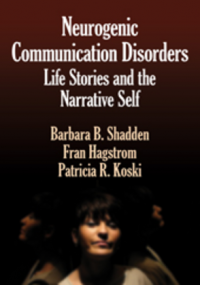Research Investigates Rebuilding Identity When Communication Is Impaired

What happens to a person’s identity when a stroke or a disease profoundly impairs the ability to communicate? In Neurogenic Communication Disorders: Life Stories and the Narrative Self, University of Arkansas researchers challenge readers to explore "the messy but powerful relationships between communication impairment and maintenance of a viable sense of self."
Speech-language professors Barbara B. Shadden and Fran Hagstrom and sociologist Patricia R. Koski brought their diverse interdisciplinary perspectives to bear on questions of the construction of a sense of self and the approach to treatment for individuals with serious communication disorders.
“At the heart of our work is the premise that everyday communicative acts and interactions are powerfully linked to who we are, as we see ourselves and as others see us,” the researchers wrote. “If we accept this premise, it alters our perception of what is ‘broken’ and what needs to be ‘fixed’ for those living with acquired communication disorders.”
The researchers looked at people affected by the neurogenic communication disorders associated with stroke, amyotrophic lateral sclerosis, Parkinson’s disease, Alzheimer’s disease and other dementias.
To maintain the narrative self, an individual must first be able to recognize the disruption the disorder creates in the life story. Then, the person can create a new narrative that includes the illness and bridges past self to present self.
“The way you create yourself is that you tell a story,” Koski said. “Think of how you present yourself to other people. You tell a story. It’s not just a presentation of self - it’s a creation of self.”
“But if something happens to that communication tool that lets you tell that story,” Shadden said, “then how do you do it? How do you create yourself? What do you do if your tool has failed you and others don’t know who you are?”
A cultural tool is more than the act of speaking and using language. Cultural tools include, among other things, beliefs, assumptions, values, posture, gestures, facial expressions and assistive devices. For people who have lost their ability to use language, assistive devices may involve computer programs or other people.
“In my discipline people think if you get the right computerized device into someone’s hands that will solve the problem. That’s the easy part,” Shadden said. “What matters about a tool is what you do with it.”
When people with neurogenic communication disorders are involved with the medical system, their role as patients reshapes their life stories. Often they begin to see themselves as powerless, incompetent and socially marginal. The researchers’ goal is to offer a new perspective to clinicians, emphasizing living with the communication disorder “rather than curing the communication impairment.”
Additionally, Shadden wrote, “In our desire to help persons improve speech-language skills, we may run the risk of failing to help them recognize the resources within, the core personal and interpersonal strengths and commitments that can sustain them over time.”
As an example of treatment that facilitated the rebuilding of a life story, the researchers discussed ongoing communications groups hosted by the University of Arkansas Speech and Hearing Clinic. The life-stories groups began as conversational groups that evolved into the life-stories format when one group decided to create a timeline of key life events for both clinicians and clients.
“What is truly remarkable is the transformation of our clients and student clinicians when they become involved in such a group,” the researchers wrote. “We see many facets of our clients that do not emerge in more traditional one-on-one therapy.”
The researchers have found the book to be useful both to speech-language professionals and to family members of those with neurogenic communication disorders.
“Different people will read different sections of the book,” Hagstrom said. “Family members will be able to read about others’ experiences and identify.”
Hagstrom suggested several ways family members of those with neurogenic communication disorders could use the book. Individual chapters present information about the disease process for amyotrophic lateral sclerosis, Parkinson’s disease, stroke, Alzheimer’s disease and other dementias. Subsequent chapters offer the experiences of individuals and their families confronted with one of these disorders, and through reading about these experiences, family members can understand the theory behind the book, the reconstruction of the narrative self.
“I’d also hope that the book would offer an answer that family members may not know they are seeking - ‘What will this disease mean to me?’” Hagstrom said.
Noting that they “have laid the conceptual foundation for relatively uncharted territory in clinical work,” the researchers acknowledge that “little is known about the maintenance, evolution and/or decline of narrative self and about the factors that influence these processes.” They call for further research and clinical trial interventions.
Shadden is a professor of communication disorders, and Hagstrom is an associate professor and director of the University of Arkansas Speech and Hearing Clinic, both in the College of Education and Health Professions. Koski is an associate professor in the department of sociology and criminal justice and associate dean of the Graduate School. Neurogenic Communication Disorders is published by Plural Publishing.
Provided by University of Arkansas (news : web)















